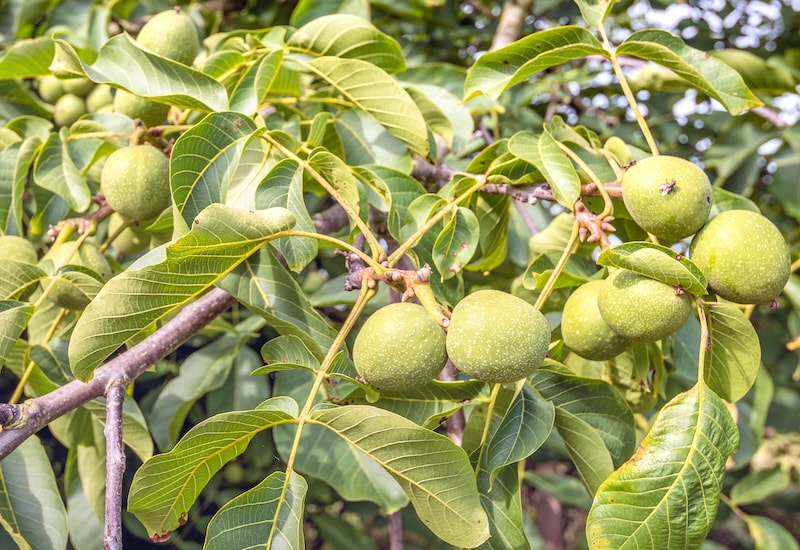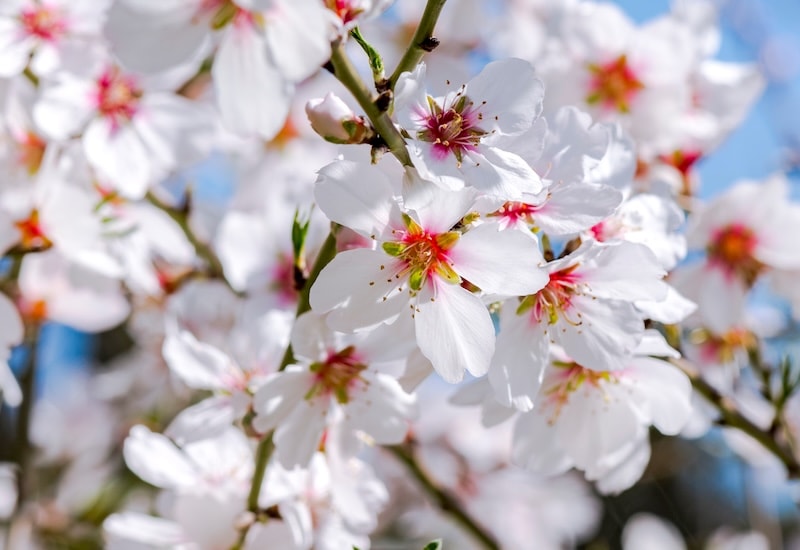Nut trees are attractive, easy to grow, and the edible crop is a delicious source of plant-based protein. What’s more, the trees are smothered in pretty blossom every spring and the nuts are usually ready to harvest from late summer.
Hazelnuts and filberts are native to the UK while almonds, walnuts and sweet chestnuts were introduced by the Romans. If you’re thinking of planting a fruit tree, why not consider a nut? Some varieties are more suited to large gardens, but others are available on dwarf rootstocks or can even be planted as an edible hedge! We asked the horticultural team at Suttons for their top tips.
Browse our full range of nut trees to find the best variety for your garden.
How to grow walnut trees

Image: Walnut ‘Lara®’ from Suttons
A walnut tree is a magnificent sight and, although they’re fairly slow-growing, a mature tree can reach 30 metres tall. If you don’t have space for something quite that big, a variety like Walnut ‘Lara’ will eventually reach a mature height of 12m, while the silvery grey bark and colour-changing foliage of Walnut (Juglans) ‘Broadview’ makes it a popular choice for smaller gardens where it will grow to 6m tall. If you’re really short of space, don’t despair. The especially dwarf Walnut ‘Europa’ grows to just 3.5m. All walnuts are self-fertile so you can get a good crop from a single tree.
Brought to the UK by the Romans who carried the nuts with them as they marched, walnuts were prized as a source of food and pressed to make cooking oil. In mediaeval times, it was believed that the nut’s resemblance to the human brain meant it could be used to cure mental disorders. The Greeks called it the “royal nut” and it features in many of their myths and legends.
Walnuts are rich in protein, antioxidants and omega 3 fatty acids. Not only do they taste delicious, they’re also a healthy food choice. In fact, walnuts are used in many things including cakes, liqueurs, coffee, and salad dressings. Immature walnuts can be harvested while they’re still green and pickled, and walnut shells can be ground into flour and used as a paint thickener.
How to grow almond trees

Image: Almond ‘Ingrid’ (St Julien A rootstock) from Suttons
Native to Asia and the Middle East, almonds were first cultivated as far back as 3,000 BC. Open-branched and beautiful, they can grow to about 9m tall. The pink, delicately scented blossom is a joyful sight in spring but the tree requires a very good summer and frost-free winter to produce nuts. However, even if your almond trees don’t produce a crop, they’re still worth growing for their decorative shape and lovely blossom alone.
Choose a sunny spot for your almond tree, away from the wind. Close to a south-facing wall is perfect for a variety like Almond ‘Ingrid’ (St Julien A rootstock) as it flowers in March and April and needs protection from late frosts. Reaching a height of about 5m, it’s one of the most reliable croppers in the UK. If you don’t have much space, try Almond ‘Robijn’ – a bright conservatory would even work for this highly ornamental tree as it only reaches 3.5m tall.
Once seen as a luxury foodstuff, almonds were often presented as a gift. In ancient Rome, almonds were thrown over newlyweds as a fertility charm, just as sugared almonds are often given at modern wedding ceremonies today. ‘Almond Legend Cake’ is a tradition enjoyed by many on New Year’s Eve – a whole almond is baked inside the cake and whoever gets the piece containing the nut is destined to have good luck in the coming year.
Almonds are very high in vitamin E, protein, magnesium, calcium and potassium so are a really healthy snack. They’re used to make both sweet and savoury things like bread, almond butter, cakes, pastries and marzipan.
How to grow hazel and filbert trees

Copyright: Floramedia
Hazelnuts, filberts and cobnuts are all part of the same genus (Corylus). Native to the UK they’re very hardy and easy to grow, and will even thrive in partial shade, unlike other nut trees. These trees are monoecious, meaning that the male catkins and female flowers appear on the same tree, making them very attractive to pollinators. However, hazel trees need a pollination partner to produce nuts, so if there aren’t any nearby, you’ll need to plant a pair.
There are many beautiful varieties to choose from. We love the striking red foliage of Hazelnut ‘Red Cracker’ which has pretty yellow catkins through the winter and grows to 3m tall. Purple Filbert is another attractive tree with rich copper foliage, deep purple catkins and purple fruit. Often grown as a hedge, it makes a colourful screen to protect other plants in exposed sites. Also popular is Filbert ‘Cosford’ which reaches a maximum height of 4m, produces good yields of large nuts and is an excellent pollinator for other trees.
In times gone by, filbert stems were used to build primitive coracles and many houses were built on a woven framework of filbert and hazel before being coated with a mixture of mud and straw to form walls (wattle and daub).
The filbert nut is used in the same way as hazelnuts and cobnuts. The only difference being that the filbert can be larger with a longer husk. Rich in protein and unsaturated fat, filberts are used in both sweet and savoury dishes. Praline is made using filberts and hazelnuts and the chocolate spread, Nutella uses 25% of the global supply!
Walnuts, almonds and filbert nuts are all lovely eaten fresh from the tree, but for storing they need to be dried. This is easy enough. Simply remove the nuts from their shells, spread them out and allow them to dry in a warm, ventilated place for about a week. Then store them in airtight containers. Just don’t tell the squirrels where you’ve put them! Looking to plant more ornamental edibles in your garden? Check out our range of fruit trees for more inspiration.
Lead image: Nut Tree – Walnut Europa from Suttons



